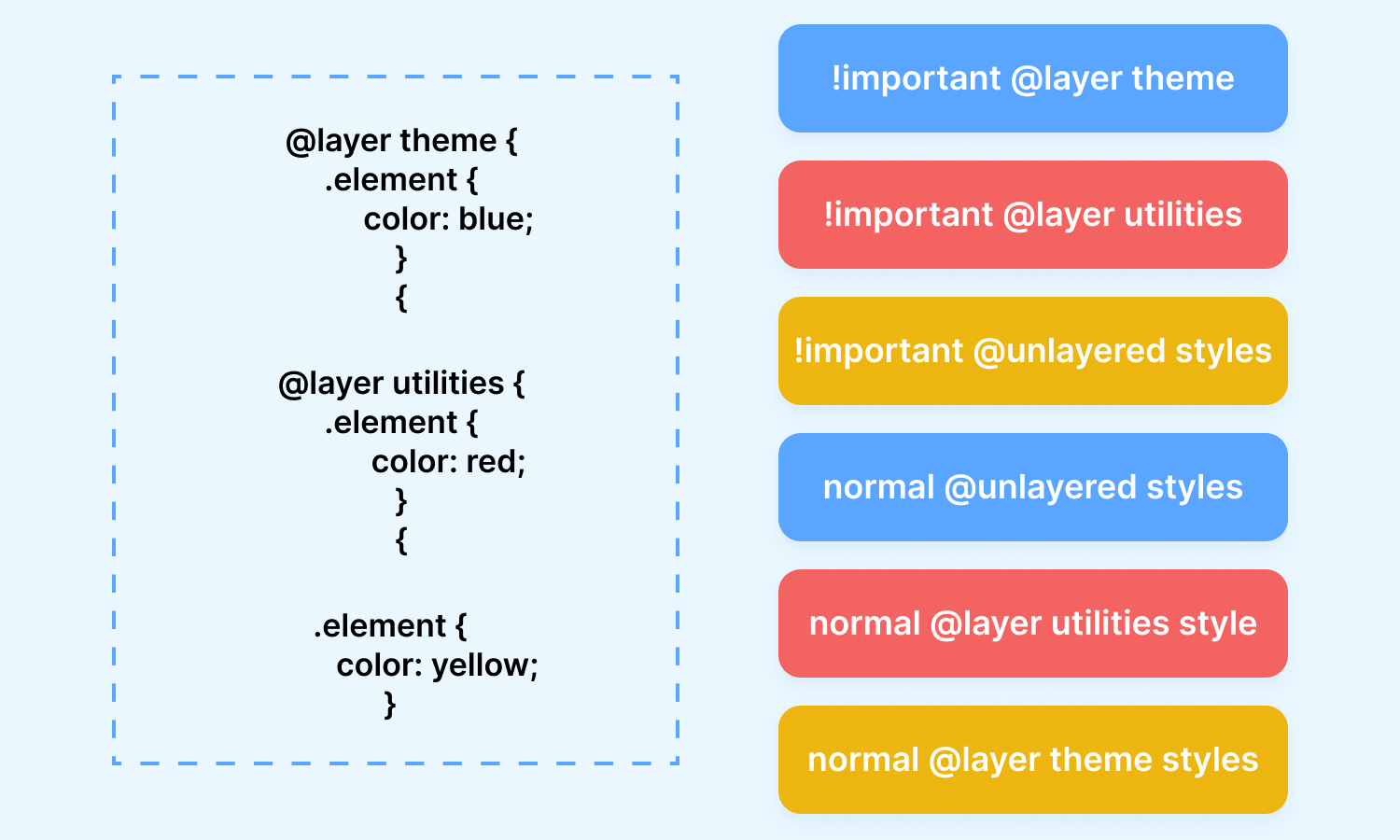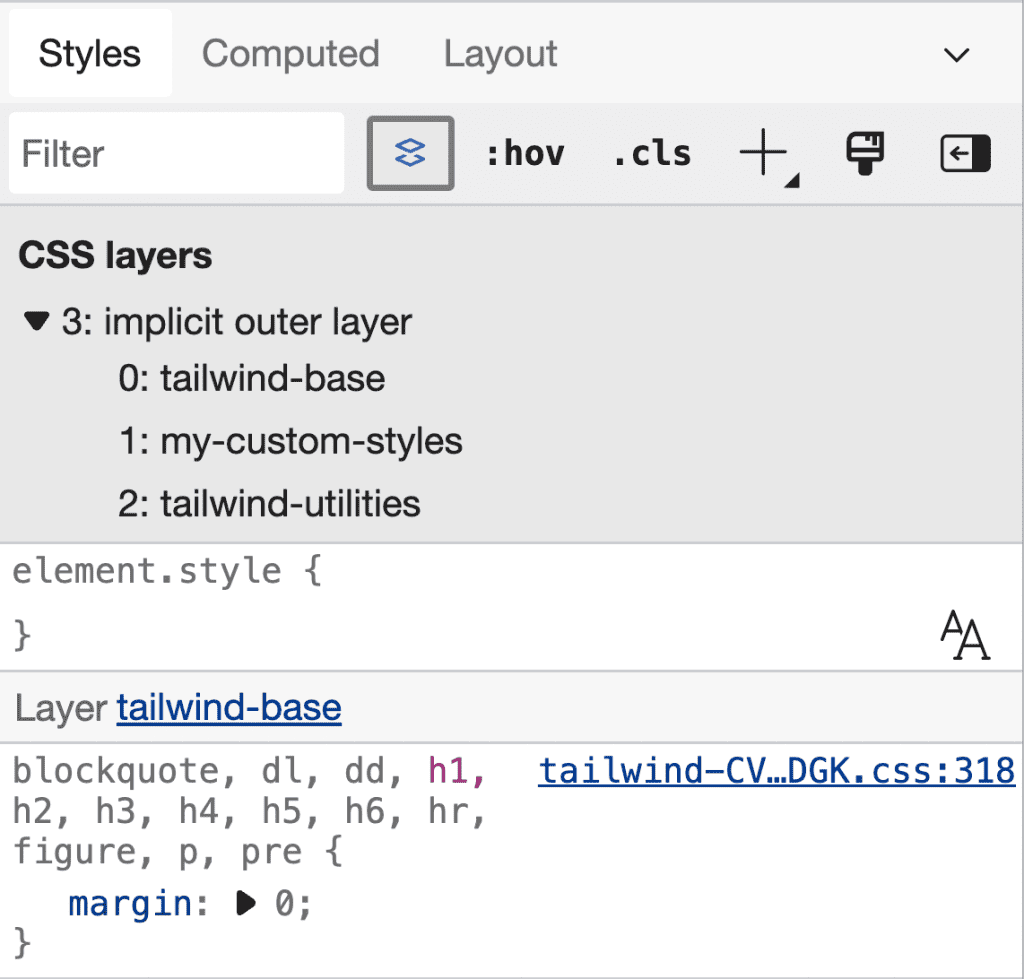CSS Cascade Layers with Tailwind have revolutionized the way developers approach front-end styling. By seamlessly integrating these innovative CSS layers into Tailwind’s utility-first framework, users can now prioritize their styles more effectively than ever before. The ability to define a clear hierarchy among base styles, components, and utilities not only simplifies the code management process but enhances the theming capabilities inherent in Tailwind CSS. This powerful method allows for quick adjustments and maintenance, paving the way for more dynamic and responsive web design. Embracing Tailwind’s utilities in combination with cascade layers significantly streamlines workflows in modern web development.
Dive into the world of CSS layers within Tailwind, an essential tool for efficient styling in contemporary web development. By leveraging utility-first design principles, developers can effectively manage style hierarchies using cascading layers that prioritize various aspects of their CSS. This approach not only simplifies complex theming processes but also enhances the overall flexibility in front-end design. With the integration of Tailwind’s extensive utility framework, creating responsive and visually appealing layouts becomes an effortless and streamlined experience. Experience the synergy of traditional CSS and modern utility classes to elevate your styling techniques to new heights.
Understanding CSS Cascade Layers
CSS Cascade Layers are a powerful tool that helps developers organize their styles more effectively, allowing for better control over the prioritization of styles. When utilizing CSS Cascade Layers, layers can designate which styles take precedence over others. Adam Wathan, the creator of Tailwind, has integrated this concept into Tailwind’s workflow, effectively enabling users to enhance their CSS management.
The beauty of Cascade Layers lies in their ability to organize styles in a clear hierarchy. By structuring components, utilities, and other styles into defined layers, developers can avoid conflicts and ensure that the correct styles are applied in the intended order. This essential understanding allows for an organized approach to styling that can lead to more manageable and maintainable code.
Choosing the Right Layer Order
When working with Tailwind, you are presented with a choice regarding the layer order, which significantly affects how your styles are applied. The recommended approach suggests structuring your styles with components first, followed by utilities. This can be seen in the example of wrapping components within a @layer directive, followed by Tailwind utilities, ensuring that your custom styles maintain order.
However, some developers, like myself, have found that the default choice may not always be the most efficient. After extensive experimentation, I advocate for an alternative approach that emphasizes an unnamed layer option. This technique allows for a more fluid writing style where the priority shifts naturally and can even maximize the strength of Tailwind utilities.
The Power of the Unnamed Layer
Utilizing an unnamed layer offers flexibility and simplicity. By writing your CSS without explicitly assigning a layer, you can swiftly overwrite Tailwind utilities as needed. This approach eliminates the clutter of multiple defined layers, simplifying the coding process.
Moreover, the unnamed layer approach promotes a more streamlined workflow. Developers can easily implement complex designs that might be cumbersome with Tailwind alone. This not only enhances productivity but also reduces cognitive load, allowing for a focus on creativity rather than navigating through tangled utility classes.
Introducing the Named Layer Option
Though the unnamed layer option has its advantages, some developers might prefer to use named layers to maintain clarity. By creatively naming layers, such as adding a ‘css’ layer, you can enforce a degree of organization while still gaining the benefits of cascade management.
Using a named layer enables developers to easily identify where specific styles are coming from, which can be particularly useful in larger projects where multiple developers are involved. It grants a balance between the straightforward nature of unnamed layers and the organized structure of named layers.
Leveraging !important in CSS Layers
The use of the !important declaration within CSS layers can be a bit controversial, but in this context, it has a valid application. By applying !important to Tailwind utilities, you can easily elevate the priority of those styles over custom declarations, provided you use it thoughtfully.
This uses CSS layering rules to create a priority dynamic, ensuring that your Tailwind utilities will take precedence where needed. This clever utilization of !important ensures that you can maintain clean and maintainable code while also responding to immediate styling needs.
The Aesthetic of Tailwind Utilities
Tailwind’s utilities are often perceived as mere class descriptors, mapping directly to CSS properties. However, they function more like sophisticated Sass mixins, granting users the ability to harness powerful styling tools without becoming mired in complex styles.
Instead of viewing these utilities as limiting, they can be recognized as the foundation for more advanced designs, facilitating the construction of layouts, theming, and typography. With a nuanced appreciation of Tailwind, developers can unlock its full potential and create stunning, effective designs.
Personalizing Your Tailwind Experience
The journey of mastering Tailwind is personal and often requires each developer to find their unique approach. My own experience has been shaped by trial, error, and a philosophy that leans towards an innovative use of CSS layers. This has helped me find joy and efficiency in the development process.
Exploring the unorthodox methods within Tailwind allows developers to break free from conventional practices, experimenting with new ideas that can enhance their workflow. By challenging the status quo, one can discover new avenues of creativity and craftsmanship in web development.
Revolutionizing Your CSS Strategy
In summation, leveraging CSS Cascade Layers with Tailwind presents a multitude of strategic advantages. By understanding and implementing the different layer options, developers can create tailored solutions that enhance both functionality and client satisfaction.
It’s not just about following the norm; it’s about constructing a personalized strategy that resonates with your workflow and objectives. As you explore the depths of Tailwind and CSS layers, you may find revolutionary techniques that redefine your approach to web development.
The Future of CSS and Tailwind
As CSS continues to evolve, developers are presented with the opportunity to adopt new strategies that will define the future of styling in web development. Tailwind, with its integration of CSS Cascade Layers, represents a critical evolution in responsive design and efficiency.
The fusion of innovative CSS practices with Tailwind’s utility-first approach could set a new standard. With continued exploration and mastery of these tools, developers stand on the brink of crafting beautifully designed, fully responsive, and maintainable web applications.
Concluding Thoughts on Tailwind and CSS
In conclusion, embracing Tailwind alongside CSS Cascade Layers not only improves your design capabilities but also enhances overall development efficiency. As you experiment with your own methodologies, keep in mind that the ultimate goal is to find a harmonious balance that works best for you.
I hope this exploration of Tailwind and CSS layers has inspired you to refine your approach and consider the value of innovation in your developments. Remember, the journey of learning and adapting is ongoing, and with every project, there is always more to discover.

Conclusion: Embracing the Unorthodox with Tailwind
In conclusion, leveraging CSS Cascade Layers combined with Tailwind utilities opens up a new realm of possibilities for front-end developers. By adopting the Unorthodox Choice methodology, developers can streamline their workflows significantly. This approach allows for better organization of styles while eliminating the clutter of multiple layers, making it easier to manage and update CSS without being hindered by complexity. Furthermore, this method reinforces the idea that utility classes can act as potent tools rather than rigid constraints.
Moreover, utilizing an unnamed layer or a named layer after utilities encourages a more intuitive understanding of CSS specificity. As demonstrated, it not only simplifies the CSS structure but also promotes efficient prototyping, making swift iterations on designs a reality. As Tailwind evolves, embracing such innovative strategies can enhance productivity while fortifying developer expertise in CSS fundamentals. Thus, experimenting with these techniques is not just a trend; it’s a step toward mastering the art of modern web design.















